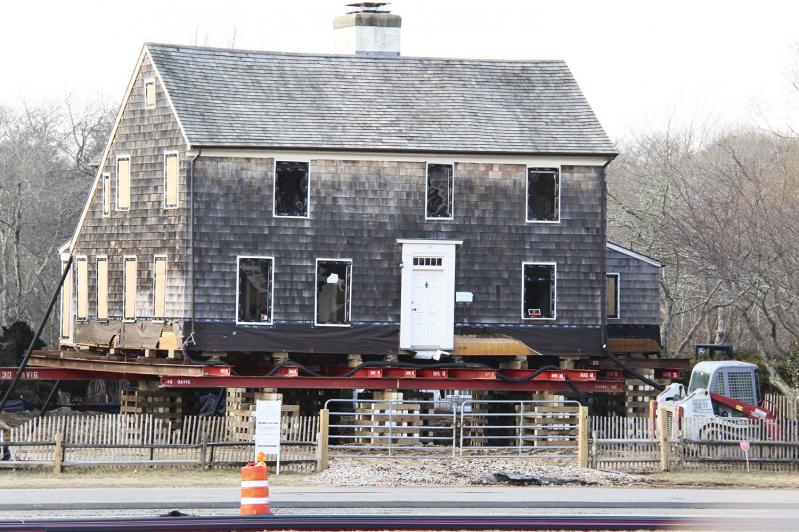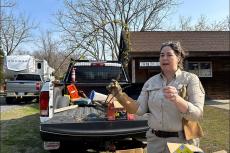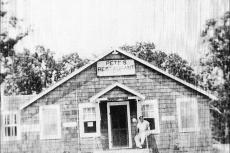Long before the name “Rowdy Hall” was adopted by a popular East Hampton Village bar and eatery (now in Amagansett), it was a boarding house: Mrs. Harry Hamlin’s Rowdy Hall. The building, now a single-family house, still stands at 111 Egypt Lane, although currently it’s floating, suspended six feet above a hole. When it’s lowered again, it will be on a new foundation.
“The floors used to roll, which was kind of charming,” Lynn Douglass, its owner, said in a phone call. “I think they will be rolling a little bit less now. The foundation will really firm things up.”
“The first time I went into that house I had to leave, because I was dizzy,” said Erica Broberg Smith, who has been practicing architecture in East Hampton for 25 years. “It was almost like being on a ship. Rowdy Hall is the most important architectural commission in my career. This may be surprising, as it doesn’t require much design work. It is not a project that proffers awards, magazine covers, or the architect’s personal style. It is a pure preservation effort.”
“One corner was sunk six inches from level,” said Kevin Warren, a co-founder of Fifth and Dune Partners L.L.C., the builder doing the foundation work. The company handling the lifting was Davis Building Movers out of Blue Point.
So how do you lift a house that’s about 300 years old? “Very, very, carefully,” Mr. Warren said. “Because the house wasn’t on a foundation, it was slowly sinking into the soil.” There was only a 30-inch crawl space below, which needed to be hand-excavated before steel beams could be slid under the house (and its original fireplace). Hydraulic jacks were used to lift it.
East Hampton Village issued an emergency building permit to start the work, which would normally have required a wetlands permit (the property backs up to the Nature Trail). “We decided to forgo it in the interest of saving the house. The structural integrity had been compromised,” said Tom Preiato, the village’s chief building inspector.
The house is also on the list of historic timber-frame homes, which benefit from their own strict preservation legislation. “At first glance it looks like a lot is going on there,” Mr. Preiato said. “The windows have been removed, for example.” The contractors will reglaze them, however, and Mr. Preiato said the village design review board didn’t need to review the application.
A front-page article in The Star from 1926 speaks to the origin of the name.
“It was the home of Henry Osborn, born in 1762, when it stood between the Presbyterian church and the David Huntting homestead. In later years it passed into the hands of Deacon David Huntting, by whom it was rented to many families in succession. After the death of Deacon Huntting, for a number of years Miss Annie Huntting conducted a summer boarding house within its walls, and later it was used as bachelor lodgings for summer boarders of the neighborhood. At this period the old house was dubbed ‘Rowdy Hall.’ “
“For all of us, it’s a passion project,” said Ms. Douglass, who was in one sense born into preservation, growing up as she did in a historic neighborhood in Brooklyn Heights, among old moldings and fireplaces. “I like old. You feel the people who came before you. I think the village is proud of it. People stop and take pictures. I used to have roses in front, until deer ate them. People noticed; they really care about the house. I feel I’m its custodian, and I’ve kept it very simple.”
“It really is daunting to take on a project of that magnitude,” said Ms. Broberg Smith. “We owe Ms. Douglass a round of applause for taking the leap as a conscious steward and saving Rowdy Hall for all of us to enjoy. I’ve gotten so many texts from people saying thank you to me. The community is definitely appreciative of it.”
“One night I was at the Baker House, just staring up at their exposed timber beams,” said Ms. Douglass. “A man noticed, and we got into a conversation about preservation. There are a lot of people out here who want to build those really big houses, but there are plenty who really love the feel and look of the past, too.”
“The most modern thing that I have is a screen that comes down in the living room so we can watch movies at night,” she added. “I don’t have a hedge. I’m very much on view. I like being out in the open, until people ask me what I was watching the night before. There’s a certain old-fashionedness, not just to the house, but to the landscaping, and the idea of community. I wish more people would take their hedges down.”
“The structure is a delightful representation of ‘shelter’ and ‘home,’ “ said Ms. Broberg Smith. “The beauty is that it doesn’t need to be anything more than just that. It’s perfect, and its inherent imperfections make it more lovely, just like all of us. The inside is like a dollhouse. It’s so beautiful.”
Ms. Douglass hopes the work is done by the summer. “I hope this tradition will continue. I feel it’s important for East Hampton to preserve these old babies. The house just has a really good feeling when you’re inside.”




